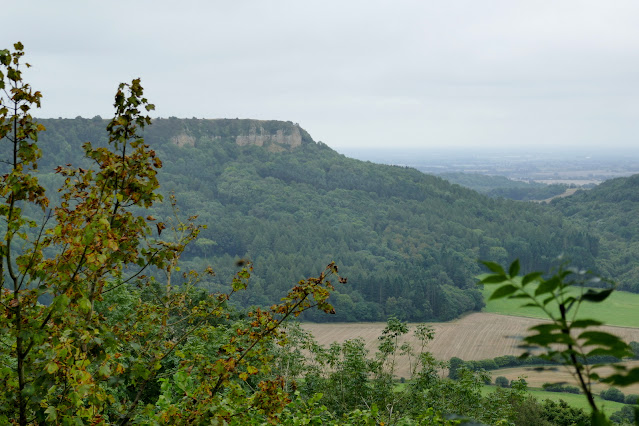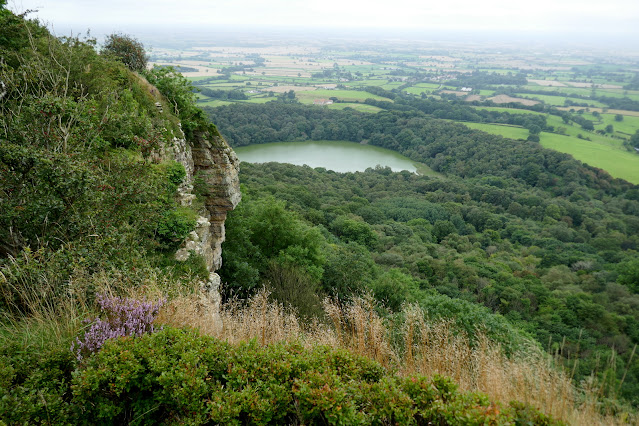Boltby to Gormire Lake and Whitestone Cliff
7 miles Occasional drizzle
We reached Boltby from the A19 Knayton turn off and drove right through the village and up a steep hill to the small designated car park at the side of the road. Unfortunately a sign informed us that the car park was out of use as lorries were using it to turn around so we returned into Boltby and parked at the side of the road, near to the church.
 |
| Today's walk from The Walker's Guide to the Hambleton Hills |
We walked back up the high street and took the first right into a lane.
Tom Scott Burns explains that Boltby is of great antiquity and is mentioned in the Domesday Book as the property of Hugh, son of Baldric.
We walked up the lane past the last of the houses and went through a gate to follow a faint track over the shoulder of Little Moor to drop down to Greendale Farm.
 |
| Passing the old packhorse bridge as we walk through Boltby |
 |
| Years ago when we first did this walk these two dogs were alive and playing in the garden |
 |
| Attractive house in Boltby |
 |
| Following the lane out of the village |
After circumnavigating Cow Pasture Wood we dropped down to Greendale Farm and followed the path around the side of a hill to reach Tang Hall Farm where the way turns left just before the buildings to enter fields.
 |
| Crossing Boltby Beck.. |
 |
| .. and walking towards Cow Pasture Wood |
 |
| In Cow Pasture Wood |
 |
| Looking down on Greendale Farm |
 |
| Pass to the right of the farm.. |
 |
| ... and follow the lane to Tang Hall Farm |
 |
| Follow the path to the left of the farm buildings into fields |
After crossing a large field we joined a stony bridleway, once an old coach road, which crosses Huggon Howl to Southwoods Hall. Southwoods Hall is a very grand place which was once the real home of Seigfried Farnon (real name Donald Sinclair) from the James Herriot books. Sinclair married into money, his wife Audrey Adamson came from a wealthy shipbuilding family and it was her money that bought their home. Strangely TSB doesn't mention James Herriot in any of his guides.
 |
| Southwoods Hall is almost hidden by trees |
 |
| Crossing Huggon Howl towards Southwoods Hall |
 |
| The hall is hidden from view by trees to our left |
 |
| We pass the south gate to the hall |
We were kept to the bridleway across Huggon Howl by new fencing that stretched past the hall to reach the trees at Midge Hole Gate and the gated south entrance to the hall. We now turned into South Woods on a forest path which we followed to reach Southwoods Lodge.
 |
| South Woods |
 |
Southwoods Lodge
|
On reaching the lodge we followed the track straight ahead through Garbutt Wood, eventually reaching Gormire Lake where we sat by the water's edge and had a peaceful break enjoying our coffee and scones. This lake is featured in the introduction to 'The Yorkshire Vet' on TV.
I think it is worth mentioning again that in 2018 we saw a Golden Pheasant in the trees of Garbutt Wood. There are only about 100 breeding pairs in the country and they are notoriously secretive so we were very pleased with ourselves but I was less pleased with my photos which were not of the best quality!
 |
| Garbutt Wood |
 |
| We reach the lake |
 |
| The water was very green today, perhaps algae bloom? |
 |
| "What is this life if full of care......" |
 |
| Golden Pheasant in 2018 |
There are two terraces around Gormire and TSB explains that these were once shorelines when the lake was much deeper. It is often described as bottomless but is actually about 27 feet deep in the centre and covers about twenty six acres. Tradition has it that a town stood here which was destroyed in an earthquake, but the lake is actually the result of a glacial overflow channel being blocked by a landslip, hence its position up a hillside. No streams flow from it and its waters are mainly supplied by rain and diminish with evaporation. A major landslip happened here on the 25th March 1755 which was described by Rev John Wesley as 'like many cannons or rolling thunder'.
Finally it was time to go and leaving the lake we climbed straight up through Garbutt Wood to reach Sutton Brow. This is a steep half mile diagonally up the side of the bank with views to the south across Happy Valley to Hood Hill Plantation. Reaching the top there is a fine view down to Gormire Lake and over towards Roulston Scar. After catching our breath we set off past Whitestone Cliff, still enjoying James Herriot's "best view in England" from various vantage points.
Eventually we passed by the remains of an old hill fort and quarry and reached the derelict High Barn where we left the ridge at a sign, turning left to descend towards Boltby.
A steep downhill took us past Hesketh Grange Farm, over a couple of bridges and then steeply back uphill, towards Boltby and TSB's 'official' car park. We had to turn left and walk downhill back through the village to the car.
 |
| A steep descent from the ridge |
 |
| Crossing Boltby Beck again |
 |
| We emerge where we 'should' have been parked |
 |
| We approve of this sign! |
 |
| Entering Boltby Village |
 |
| Hikers can be sure of a warm welcome in Boltby! |
There is no pub in Boltby so we made the short drive to Osmotherley for our post walk pint, passing, as we did so, some interesting roadside figures in Knayton.
 |
| Richard Branson in Knayton |
 |
| Not sure who this is! |
A nice walk and worth doing for the views of Gormire alone!





























































































